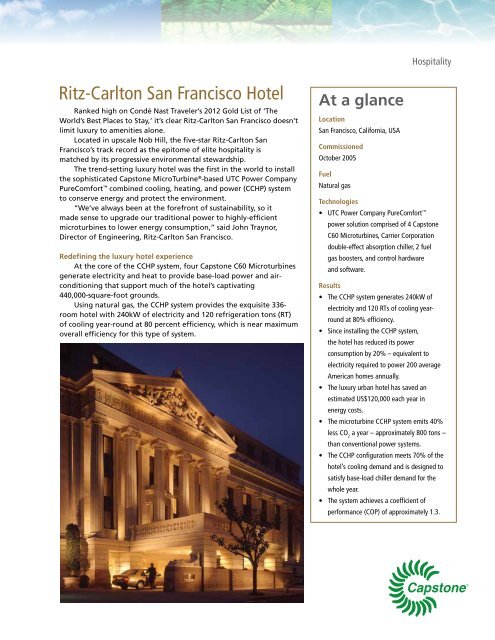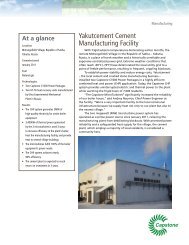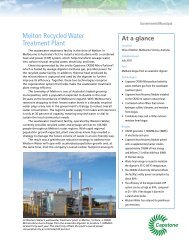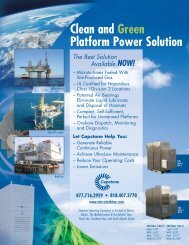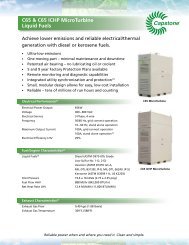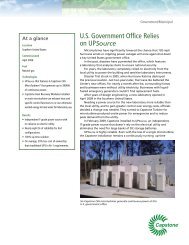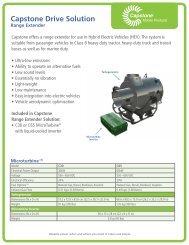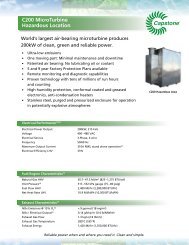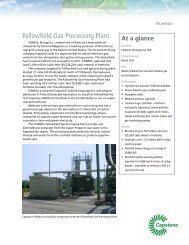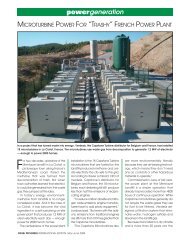Ritz-Carlton San Francisco Hotel - Capstone Turbine
Ritz-Carlton San Francisco Hotel - Capstone Turbine
Ritz-Carlton San Francisco Hotel - Capstone Turbine
Create successful ePaper yourself
Turn your PDF publications into a flip-book with our unique Google optimized e-Paper software.
Hospitality<br />
<strong>Ritz</strong>-<strong>Carlton</strong> <strong>San</strong> <strong>Francisco</strong> <strong>Hotel</strong><br />
Ranked high on Condé Nast Traveler’s 2012 Gold List of ‘The<br />
World’s Best Places to Stay,’ it’s clear <strong>Ritz</strong>-<strong>Carlton</strong> <strong>San</strong> <strong>Francisco</strong> doesn’t<br />
limit luxury to amenities alone.<br />
Located in upscale Nob Hill, the five-star <strong>Ritz</strong>-<strong>Carlton</strong> <strong>San</strong><br />
<strong>Francisco</strong>’s track record as the epitome of elite hospitality is<br />
matched by its progressive environmental stewardship.<br />
The trend-setting luxury hotel was the first in the world to install<br />
the sophisticated <strong>Capstone</strong> Micro<strong>Turbine</strong> ® -based UTC Power Company<br />
PureComfort combined cooling, heating, and power (CCHP) system<br />
to conserve energy and protect the environment.<br />
“We’ve always been at the forefront of sustainability, so it<br />
made sense to upgrade our traditional power to highly-efficient<br />
microturbines to lower energy consumption,” said John Traynor,<br />
Director of Engineering, <strong>Ritz</strong>-<strong>Carlton</strong> <strong>San</strong> <strong>Francisco</strong>.<br />
Redefining the luxury hotel experience<br />
At the core of the CCHP system, four <strong>Capstone</strong> C60 Microturbines<br />
generate electricity and heat to provide base-load power and airconditioning<br />
that support much of the hotel’s captivating<br />
440,000-square-foot grounds.<br />
Using natural gas, the CCHP system provides the exquisite 336-<br />
room hotel with 240kW of electricity and 120 refrigeration tons (RT)<br />
of cooling year-round at 80 percent efficiency, which is near maximum<br />
overall efficiency for this type of system.<br />
At a glance<br />
Location<br />
<strong>San</strong> <strong>Francisco</strong>, California, USA<br />
Commissioned<br />
October 2005<br />
Fuel<br />
Natural gas<br />
Technologies<br />
• UTC Power Company PureComfort <br />
power solution comprised of 4 <strong>Capstone</strong><br />
C60 Microturbines, Carrier Corporation<br />
double-effect absorption chiller, 2 fuel<br />
gas boosters, and control hardware<br />
and software.<br />
Results<br />
• The CCHP system generates 240kW of<br />
electricity and 120 RTs of cooling yearround<br />
at 80% efficiency.<br />
• Since installing the CCHP system,<br />
the hotel has reduced its power<br />
consumption by 20% – equivalent to<br />
electricity required to power 200 average<br />
American homes annually.<br />
• The luxury urban hotel has saved an<br />
estimated US$120,000 each year in<br />
energy costs.<br />
• The microturbine CCHP system emits 40%<br />
less CO 2<br />
a year – approximately 800 tons –<br />
than conventional power systems.<br />
• The CCHP configuration meets 70% of the<br />
hotel’s cooling demand and is designed to<br />
satisfy base-load chiller demand for the<br />
whole year.<br />
• The system achieves a coefficient of<br />
performance (COP) of approximately 1.3.
“The big payback is the tremendous<br />
amount of heat that comes from the<br />
four microturbines. Heat recovery is<br />
key to reducing a hotel’s energy<br />
consumption and costs.”<br />
— John Traynor, Director of Engineering<br />
<strong>Ritz</strong>-<strong>Carlton</strong> <strong>San</strong> <strong>Francisco</strong><br />
For <strong>Ritz</strong>-<strong>Carlton</strong>, guest comfort is paramount, which<br />
makes the quiet, low-vibration microturbines an ideal<br />
power source for the hotel’s relaxing ambiance.<br />
Reduced consumption, costs, and emissions<br />
According to Traynor, purchasing the CCHP system<br />
resulted from an ongoing plan to lower the hotel’s<br />
energy consumption and reduce energy expenses.<br />
“The hotel’s parent organization strongly wanted<br />
to deploy the highly efficient CCHP system to offset<br />
energy loads,” Traynor said. “Our philosophy is to<br />
reduce our carbon footprint and minimize our impact<br />
on our community and the environment. We’re always<br />
looking to advance our sustainability profile and<br />
<strong>Capstone</strong> microturbines align with our corporate<br />
vision for environmental stewardship.”<br />
With a 1MW peak electricity demand and<br />
significant chilling requirements that approach 300<br />
RTs, <strong>Ritz</strong>-<strong>Carlton</strong> <strong>San</strong> <strong>Francisco</strong> needed a cleaner, more<br />
efficient power system to align with its industry-leading<br />
corporate standards for conservation.<br />
The hotel’s original inefficient 300 RT electric chiller<br />
ran 24/7 year-round, even though the hotel’s chilling<br />
needs often were well below the chiller’s capacity.<br />
Today’s newer microturbine-based CCHP configuration<br />
meets 70 percent of the hotel’s cooling demand and<br />
is designed to satisfy base-load chiller demand for<br />
the whole year. This allows the facility to shut off the<br />
inefficient 300 RT chiller for eight months each year.<br />
“The big payback is the tremendous amount of<br />
heat that comes from the four microturbines,” Traynor<br />
said. “Heat recovery is key to reducing a hotel’s energy<br />
consumption and costs.”<br />
Exhaust heat from the four microturbines is<br />
captured by a Carrier Corporation 120 RT double-effect<br />
absorption chiller, which can be manually configured<br />
to operate as either a chiller or heater. When in cooling<br />
mode, the chiller recycles the microturbines’ exhaust<br />
heat to achieve a COP of approximately 1.3.<br />
Since the rooftop CCHP system was commissioned<br />
in 2005, the lavish hotel has reduced its energy<br />
consumption 20 percent and saved an estimated<br />
US$120,000 each year in energy costs. With financial<br />
support from California’s Self Generation Incentive<br />
Program and the U.S. Department of Energy, the hotel’s<br />
return on investment took less than four years.<br />
According to the Pacific Region CHP Application<br />
Center, the <strong>Capstone</strong> microturbine system at <strong>Ritz</strong>-<strong>Carlton</strong><br />
<strong>San</strong> <strong>Francisco</strong> saves enough electricity annually to power<br />
200 average American homes.<br />
With such tremendous energy savings, greenhouse<br />
gas emission reduction is inevitable. The clean-and-green<br />
<strong>Capstone</strong> system emits 40 percent less CO 2<br />
a year than<br />
conventional systems – a benefit equal to planting 150<br />
acres of pine and fir forest. In fact, the CCHP system<br />
reduces 800 tons of CO 2<br />
each year when compared with<br />
traditional onsite energy systems.<br />
Additionally, with NOx emissions less than nine parts<br />
per million at 15 percent exhaust oxygen, the <strong>Capstone</strong><br />
system emits 90 percent less NOx a year than conventional<br />
systems, which is equivalent to removing 250 cars from<br />
the road.<br />
The CCHP system at the hotel requires nominal<br />
maintenance compared to its traditional system.<br />
“The microturbines run all the time with minimal<br />
maintenance,” Traynor said. “The past six years have<br />
been a good performance indicator.” •<br />
Four 60kW <strong>Capstone</strong> microturbines provide cooling, heating, and power<br />
to the prestigious <strong>Ritz</strong>-<strong>Carlton</strong> hotel in <strong>San</strong> <strong>Francisco</strong>.<br />
21211 Nordhoff Street • Chatsworth • CA • 91311 • 866.422.7786 • 818.734.5300 • www.capstoneturbine.com<br />
©2012 <strong>Capstone</strong> <strong>Turbine</strong> Corporation. P1012 Case Study CAP409


